Enjoying the Birds of the Ottawa Valley
Birds Around the Home
Birds are especially valued because they come to us, to our
backyards. Our first memory is, for many, of a robin that frequented
our childhood vegetable garden. And, most who become actively
involved in watching birds begin by feeding birds in the winter, or
by putting up a nest box. Here is how best to attract birds to your
Valley garden, all year around.
To Feed or Not to Feed
There are two kinds of people who feed birds - those who love 'em
all, and those who don't. The former happily fill convenient silo
feeders with "wild bird seed" winter and summer, and are
content with the world. There are enough of them that at least 400
tons of seed mix are sold in the Valley each year.
Then there are the others. They scan books on attracting birds like
our parents did Dr. Spock. They spend hours in voluble prayer for
deliverance from squirrels, pigeons, house sparrows, whatever. Are
evening grosbeaks golden treasures, or "grospigs"? Are you
afraid that your kids will copy a blue jay stuffing its face, or do
you hope that they will admire the glorious blue of its coat and its
rich vocabulary? No matter, someone agrees with you. One Pine Glen
resident stopped putting out seed because she was bored with so many
goldfinches. A Stittsville household hopes for a repeat of the
glorious time when an estimated 50,000 redpolls descended on their
yard full of feeders.
Some indulge in even worse torture to the mind. Should birds be fed
at all? Don't they get lazy coming to a feeder? If you feed birds in
the summer, at least one neighbour is sure to suggest this notion.
(Ornithologists say "no".) One Gloucester neighbour took the
idea a stage farther, and erected a whirligig Tweety-bird and
Sylvester as close to a feeder as he could, in hopes of saving the
souls of a few of the birds. (The bird lover answered with a plaster
statue of St. Francis, the Roman Catholic patron saint of birds. He
fed birds all year around.)
Don't feeders entice birds to stay here, when they should migrate?
Again, ornithologists say "no". Birds whose genes reflect
their species' history leave here long before their natural food runs
out. Nature's seed and berry supply rarely runs low before January.
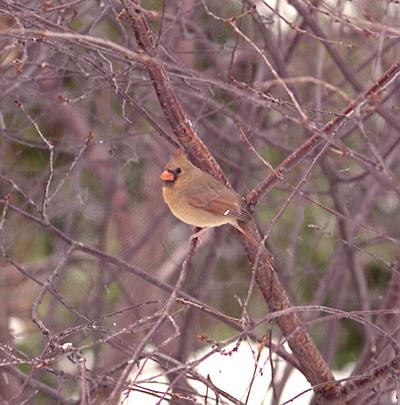 Don't feeders encourage misfits to survive in violation of nature?
Every year, it is true, many birds, due to some flaw, do not migrate
as they should. A few are attracted to the area of a feeder during
their last days. But, such birds as the Christmas 1984 black-throated
green warbler in Hull will not survive the winter, feeders or no
feeders. Birds that stay here successfully to expand their range are
generally non-migrants, such as cardinals. They need only suitable
food to handle winter temperatures. We have done so much to curtail
many bird ranges through destruction of food-providing wetlands.
(Roger Tory Peterson once estimated that half a billion birds had
been eliminated from North America "by the simple process of
digging ditches".) Why shouldn't we take a bit of satisfaction
when we help expand some? Go for it!
Don't feeders encourage misfits to survive in violation of nature?
Every year, it is true, many birds, due to some flaw, do not migrate
as they should. A few are attracted to the area of a feeder during
their last days. But, such birds as the Christmas 1984 black-throated
green warbler in Hull will not survive the winter, feeders or no
feeders. Birds that stay here successfully to expand their range are
generally non-migrants, such as cardinals. They need only suitable
food to handle winter temperatures. We have done so much to curtail
many bird ranges through destruction of food-providing wetlands.
(Roger Tory Peterson once estimated that half a billion birds had
been eliminated from North America "by the simple process of
digging ditches".) Why shouldn't we take a bit of satisfaction
when we help expand some? Go for it!
When should you feed? Start putting food out before snow arrives.
Birds tend to have settled down by then. One Alta Vista resident even
claims that just one early-winter weekend spent chasing house
sparrows away from his feeder frees him of them for the rest of the
winter. If you are starting to feed at a new location, it may take a
while to attract clientele. Start with white bread on the ground.
It's more visible than a small feeder.
Many books insist that once you start feeding, you must keep feeding
until spring. The basis for the argument is true: a chickadee has
only a few hours in reserve on a cold winter morning to find an
alternate food source. But, banding data from urban Ottawa calls this
conventional wisdom into question. You may think that the same birds
come to your feeder all winter. In fact, in urban areas at least,
most are different birds all the time. A single backyard in
Carlingwood nets almost 3000 individual birds over the year. The big
numbers are all winter feeder birds: 1100 pine siskins (but an
average of only 17 on those days when any siskin was present), 650
goldfinches (average, 8), 450 purple finches (average, 11). An
urban-dwelling bird here seems to cover a dozen food sources during a
winter. If you stop feeding, it knows where other food is. So, don't
be put off by vague worries that you might have to go away during the
winter. There are 25,000 other feeders around you!
It's a tradition in my family to stick the Christmas tree in a
snowdrift on the New Year, then festoon it with suet for the birds.
When the tree topples, winter is declared over.
Feeding in the summer is likely to be rewarding only if you live in
an area with lots of mature trees and hedges, or if you are happy
surrounded by house sparrows and grackles. To watch adult cardinals
and blue jays introduce their young to your feeder can be worth any
number of grating grackles. (Don't expect every neighbour to agree.)
One family in west Ottawa has happily counted 24 young cardinals
since starting summer feeding in 1974. Another watched Ottawa's first
ever lark sparrow from her kitchen window for a week during June
1984, as it joined three fledgling crows who came for a hardboiled
egg twice a day.
Bird Seed
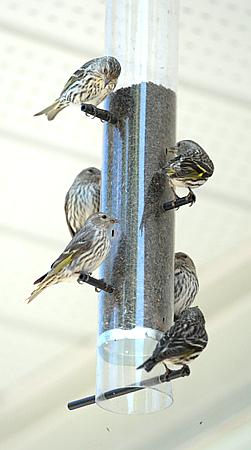 You are going to feed birds, then. What food is the best?
You are going to feed birds, then. What food is the best?
If birds are given the choice, more species prefer cracked corn than
any other food. But, cracked corn has two flaws. First, it attracts
too many birds for some, specifically pigeons and house sparrows.
More seriously, if pure cracked corn is fed in a silo feeder, the
bottom gets wet from rain or snow, the moisture wicks right up to the
top, and the result rapidly resembles set concrete. So, corn has to
be fed on a tray. The tray has to be swept clear of snow by the
watcher, and is swept clear of corn by howling wind, both at frequent
intervals in our winters. Despite these problems, it's a great feed
if you appreciate birds as they are.
Whole sunflower seed is the most popular feed with bird watchers.
It's clean looking, flows easily in feeders, and is the favourite of
many of our most colourful winter species--finches, chickadees,
nuthatches and jays. It's expensive though, and half of those
kilograms are hulls that have to be cleaned up. A flock of evening
grosbeaks can indeed be almost too much of a good thing. There are
two main types of sunflower seed, grey-striped and black (oilseed).
The large finches love the oilseed, even feeder-shy pine grosbeaks
are attracted to it, but smaller birds, including house sparrows,
have difficulty breaking it up. It's great!
(When this book was published, few outlets carried it;
now Ritchie Feed & Seed sells almost as much of it as the striped.)
The most popular food with the general public is "wild bird
mix". It usually contains grains such as wheat, chosen to keep
the price low, rather than those that birds choose if they have the
choice. It is true that modern wheat contains almost as much protein
as insects, but it's also true that essentially the only birds that
have adapted to this development are house sparrows and pigeons. A
high quality mix will include salt and grit, valuable to birds in
winter, will be finely and evenly cracked to minimize waste, and will
contain a variety of grains chosen to provide a "balanced
diet". Still, food preference studies make the choice clear. If
you think people know what is best for birds, feed wild bird mix. If
you think the birds do, don't.
Mixing whole sunflower seed with anything else is generally a waste.
Birds that prefer sunflower dump the surrounding seed on the ground
the way kids dump candy wrappers around a corner store. The same is
generally true of mixing grey-striped and oilseed sunflower. If you
have enough house sparrows around though, you can get away with
anything, even feeding wheat or rice kernels that no bird will touch
if it has a choice. Once all other food has run out, the sparrows
will clean up the leftovers.
After seeds, you probably think of rendered fat, formed into cakes
with a ridiculous assortment of additives. Really, the raw fat, hung
in a mesh bag that onions come in, works fine. So does plain peanut
butter smeared on some bark. (The widely-held belief that peanut
butter sticks in birds' throats is not held by most ornithologists.)
But if you must be the chef, mix rendered fat with a bit of peanut
butter for taste, add cornmeal until stiff, then dip large pine cones
into the mixture. Hang suet on a tree trunk if you have one -
most suet eaters are used to
bark underfoot. If suet goes rancid in summer, birds don't seem to
mind. A pair of white-breasted nuthatches in Cumberland raised two
healthy broods of young while feeding enthusiastically throughout on
a large ham rind that had been hung high in a tree early the
preceding winter.
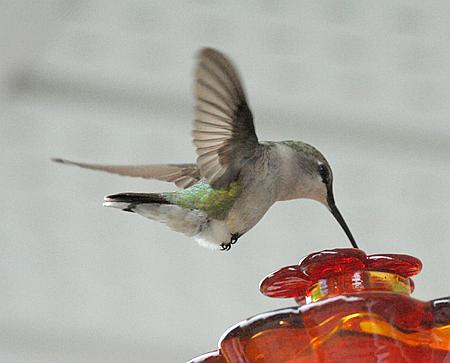 Finally, blue jays are particularly attracted to peanuts, pine
siskins are claimed to love cracked buckwheat, and goldfinches seem
to be the only species to eat whole flax. Hummingbirds take sugar
water, 1 part sugar to 4 parts water, changed every few days to avoid
fermentation. (They eat insects for protein.) Niger seed is very
attractive to small finches. But at its price, Niger is worth it only
to a feeder fanatic.
Finally, blue jays are particularly attracted to peanuts, pine
siskins are claimed to love cracked buckwheat, and goldfinches seem
to be the only species to eat whole flax. Hummingbirds take sugar
water, 1 part sugar to 4 parts water, changed every few days to avoid
fermentation. (They eat insects for protein.) Niger seed is very
attractive to small finches. But at its price, Niger is worth it only
to a feeder fanatic.
Feeding on the ground has two advantages. All birds will eat on the
ground. Many feed only on it. (Just keep the feeder away from cover
for neighbours' cats.) Also, birds such as blue jays, that normally
exclude all other birds from a feeder on a pole, allow mutual feeding
when on the ground. I have seen a dozen house sparrows, the local
family of three young blue jays, and several grackles feeding
together in and around one small tray.
So, your basic strategy should be: cracked corn on or near the ground
on a tray, whole sunflower seed in a silo at head height, and suet on
a tree trunk. Decentralize. Don't put everything so close together
that one bird or squirrel can monopolize things. Keep feeders dry and
clean so that seed doesn't get mouldy. Some moulds produce toxins
that are dangerous for birds.
If you feel that you have a pigeon problem, try tying evergreen
branches over the top of your feeder so the food slot is heavily
shaded - it might help. Many who feed in summer use only sunflower
seed or Niger, restricted to a freely-swinging feeder that house
sparrows find awkward to use.
Mammal Problems
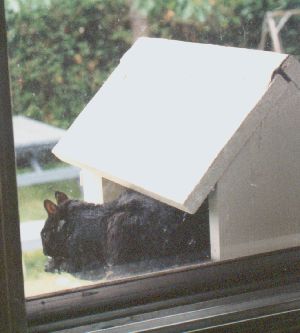 There is no doubt about it - "grey" squirrels (most in urban
Canada are black coloured, not grey) can be a problem. They are less
territorial than red squirrels are, so their population grows
impossibly. They eat appalling quantities of sunflower seed, and chew
up plastic feeders to get the last few grains out. They occasionally
rip open mesh bags and abscond with suet, too. Then, come spring,
they go after our tulips.
There is no doubt about it - "grey" squirrels (most in urban
Canada are black coloured, not grey) can be a problem. They are less
territorial than red squirrels are, so their population grows
impossibly. They eat appalling quantities of sunflower seed, and chew
up plastic feeders to get the last few grains out. They occasionally
rip open mesh bags and abscond with suet, too. Then, come spring,
they go after our tulips.
Some squirrels can jump 3 meters horizontally from a fence, others 2
meters vertically from the ground. One in Carson's Grove jumped
regularly from the top of a 3-story apartment building, and hit the
feeder every time I saw it. They climb small metal poles as easily as
trees. As for telephone wires and clotheslines, they might as well be a red
carpet!
The most reliable
squirrel stopper is a slightly flexible flat steel
disk, 60 cm in diameter. Mount it loosely on the pole below the
feeder, so it will tip and dump a squirrel that grabs the edge.
Although most squirrels don't jump more than a meter straight up, you
may have to put it 2 meters above snow level, and use a stool to fill
the feeder. If a tree branch extends within 5 meters, at any height,
you may need another disk above the feeder. Such disks are also
effective on each side of a clothesline-supported feeder that can be
reeled in to a balcony to be filled.
A one gallon paint tin, mounted open side down, encircling the pole,
stops most squirrels (but not all). A bundle of thorny (shrub rose)
twigs tied under a feeder may work, and looks more natural than
metal. Few squirrels seem to eat pure cracked corn, so ground feeding
need not be a problem.
Other rodents, specifically rats and mice, can be kept at bay by
feeding well away from cover, and by storing seed in steel garbage
cans with latching lids. Storing seed in an unheated shed, that gets
some sun to keep it from being too damp, will also prevent bugs and
overly-smart raccoons from being a problem.
Real bird lovers understand that predators such as sharp-shinned
hawks are a part of nature too. (All members of the animal kingdom
must eat other living things. Everything we eat was as alive as
birds are.) But, hawks are part of nature because they must survive in
it. Household cats need not. With no restrictions of food supply or
of shelter from the worst days, cats are free to pillage when they
choose. If you care for birds around your house, you will keep your
cat indoors, and persuade your neighbours to do the same. Urban
residents can call the "dog catcher" to help with persistent
offenders, in some municipalities. (Rural residents normally use more
direct remedies.)
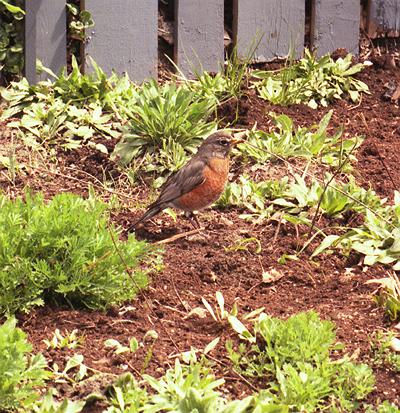
Making Birds feel at Home
Pesticides
Tons of unreasonably toxic chemicals are used because we do not weigh
their cost to our environment. Few farmers can survive economically
without using increasingly lethal substances in increasing quantity,
because we insist on buying the cheapest corn-fed beef and the
glossiest looking fruit, rather than those grown by methods that take
our environment into account. We poison birds by the thousands
because we prefer an artificially green lawn and impeccable shrubs to
a healthy environment. As Pogo put it, "We have met the enemy and
he is us".
The following sections deal with attracting birds during their
breeding season, when they will eat food grown in your neighbourhood.
If you act on any of these suggestions, think before you spray. If a
chemical is claimed to have any effect on "pests", it almost
certainly will kill some birds.
Small quantities of pests of all types can be found around the
average home. Many will not get out of hand if you do not spray. Many
common pesticides destroy essential soil organisms, producing
compacted soil in which little will grow well. You might as well
plant dandelions as use them. Some plants, such as white birch and
viburnum, are notorious for requiring pesticides to survive. If you
love birds, replace them with plants which do not have such problems here.
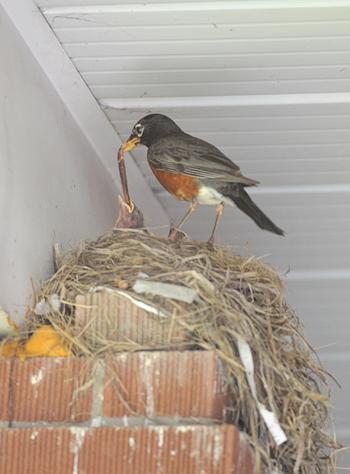 Most lawn-spray companies, for economy of application, mix their
chemicals to deal with the worst lawns within the area covered by their
day's work.
A few, however, now routinely spray only with fertilizer,
spot-spraying with pesticides only as needed. These companies also
tend to be the ones that advise you on non-chemical methods of
improving your lawn, thus reducing your need for chemicals. Ask!
Then, get a written contract specifying the chemicals and quantities
that will be used. Or, do it yourself, using the information sheets
of the
Regional Municipality of Ottawa-Carleton.
Most lawn-spray companies, for economy of application, mix their
chemicals to deal with the worst lawns within the area covered by their
day's work.
A few, however, now routinely spray only with fertilizer,
spot-spraying with pesticides only as needed. These companies also
tend to be the ones that advise you on non-chemical methods of
improving your lawn, thus reducing your need for chemicals. Ask!
Then, get a written contract specifying the chemicals and quantities
that will be used. Or, do it yourself, using the information sheets
of the
Regional Municipality of Ottawa-Carleton.
If you want worm-eating birds such as robins to survive around your
home, you will have to persuade those around you to take care with
pesticides too. A baby robin eats 4 meters of earthworms a day, six
backyards' worth. It takes very little poison residue per worm to
accumulate enough to kill a robin. In my neighbourhood, where the
lawn-spray trucks prowl, not a single robin used to survive the year,
young or adult, until the CWS succeeded in restricting their use of
diazinon in 1986. All summer long birds drifted in, one by one, from
nearby woods to fill the void, only to succumb in their turn.
Nature provides no "street-proofing" classes for robins. They
can't read "Poison - Keep Off" signs. When it comes to
man-made chemicals, it's up to us!
Point out to your neighbours that ants eat many destructive insects, and are themselves food for
birds that visit.
Some foresters even cultivate ants, for it has been shown that the trees are healthier that way.
Once a lawn is healthy, you will soon have a hard time finding such insects as grasshoppers or
earwigs on lawns
where birds feed. Birds love them. And, the best white grub control of all is a nestbox full of
young starlings.
The Perfect Bird Box
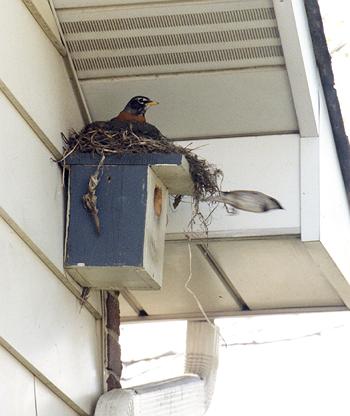 In the Valley, 28 species of birds nest in cavities, and might be
lured to stay near you by a suitable bird box. In nature there are
rarely enough nesting cavities to go around. The populations of tree
swallows and bluebirds in particular seem to be limited primarily by
the availability of nest sites, not by food. So, concocting an
easy-to-build nest box can really help birds. (To a bird, the perfect
bird box is one that gets built!) Here is a recipe.
In the Valley, 28 species of birds nest in cavities, and might be
lured to stay near you by a suitable bird box. In nature there are
rarely enough nesting cavities to go around. The populations of tree
swallows and bluebirds in particular seem to be limited primarily by
the availability of nest sites, not by food. So, concocting an
easy-to-build nest box can really help birds. (To a bird, the perfect
bird box is one that gets built!) Here is a recipe.
The Material: rough-sawn 1x6 inch cedar. The Back: 20 cm long, has
two holes for mounting screws. The Sides: 20 cm long. The Top:
overhangs back and sides by 1 cm, the front by 5 cm; has drip slots
all around. The Bottom: has corners cut out 5 mm for drainage and
ventilation. The Front: 20 cm long, has no perch to aid enemies, has
a precisely-sized entrance hole, just below the top so a cat's paw
can't reach the nestlings. Nail all pieces together, except the
front, with fence (galvanized spiral) nails. After fastening the box
to a fence or wall, attach the front with two brass round-head
screws so it can easily be opened for cleaning each fall.
The Location: height 2 meters or more, so a cat can't jump up and grab the bird as it enters or
leaves.
Barn swallows, house sparrows, starlings, and most birds that will use the top of the house for
nesting, prefer to be under the eaves of a house. Put it up in a visible place, as if it were a hole
in a dead tree or fencepost. Healthy leafy trees don't have cavities. Birds don't seem to look in
such
places for nest holes. I have an
experimental box
at the top of a high cedar hedge that has gone unused for
five years now, while identical boxes on the side of the house have been occupied every year.
The best location for a box is near a habitat edge, where lawn gives way to shrubs or trees.
The only critical dimension is the entrance hole. Make it just large enough for the nester, so it's
too small for more powerful competitors and predators: 3 cm for a house wren, chickadee or
nuthatch, 4 cm for a tree swallow or bluebird. An oval tree swallow hole 3 cm high and 5 cm
wide
keeps starlings away. Eastern phoebe and, as you can see above, robins, will use the top of
the box if it is sheltered from direct sun. If you have a problem with squirrels enlarging the
hole in hopes of a nesting spot for themselves, line the inside of the front with aluminum
sheet (not foil) - it doesn't stop them from
trying, but it keeps them from succeeding.
If you wish to attract purple martins, choose a location within a few
hundred meters of an existing occupied house, then put up a
duplicate. They require a copious supply of flying insects. Contrary
to legend, mosquitoes form only a small part of their diet. (Barn
swallows are the real mosquito eaters.) Martins are fussy about their
nesting grounds, and many martin houses are never occupied except by
starlings or house sparrows.
Never finish anything for living creatures with wood preservatives.
One application of pentachlorophenol or creosote will kill nestlings
for years to come. Pressure-treated materials often contain arsenic, a
poison forever. Leave the cedar unfinished or paint with non-toxic
acrylic (exterior latex) paint.
Put up only one box per species per 3000 square meters. With a
woodland lot, try a 20x20 cm box 30 cm high with a 5 cm hole, placed
a bit into the woods. You might get lucky with a flicker or a
great-crested flycatcher. (In the city you will get starlings in any
box with an entrance hole larger than 4 cm.)
Clean nest boxes out thoroughly after the young have left. For most
birds, raising young is a race with lice and fleas raising theirs! A
clean new nest gives the birds a head start. Few parasites of birds
have any effect on humans, but some moulds that grow on old nests can
cause strong allergic reactions in some people. Avoid breathing in
dust from nest boxes.
Building Habitat
Good architecture provides sustenance for a body and space for a
soul. Bird architecture, or habitat, must too. (A bird's soul is
conventionally called instinct. We don't know how to prove that a
bird thinks it has a soul.) As our cities become more architecturally
stable, more birds will adapt to them, and we will all be happier.
Eastern North America as a whole supports about four breeding birds
per hectare. Suburban areas support up to ten times this number,
where people care about birds.
You don't want to build just one "bird building" to go with
your home, though. You want a town, to provide for many different
species of bird in your yard. That calls for variety. To improve
habitat, look at what you have, then plant something else. In a
solidly treed lot, a chain saw is the best habitat creator ever
invented. (Pruning shears are not!) Those endless stretches of
2,4-D-purified grass so beloved by parks commissioners are nearly
sterile.
Birds' architecture uses vegetation for protection from weather,
support for nesting, and escape from predators. For weather cover,
thick cedar hedging is the Ottawa specialty. Balsam fir and spruce
are good too. For nesting cover, a thorny shrubby jungle (for birds
like song sparrows) and high mature trees (for others, such as
rose-breasted grosbeaks) make birds feel secure. A small shrub that
stands alone is poor for nesting, for a bird wants to conceal its
comings and goings. A deciduous tree with lots of small branches is
good escape cover. Birds best evade the predator they can see to
dodge.
Valley residents have two special problems as avian architects. Most
books on attracting birds are written for climates much milder than
ours, and most of their recommended plants can not survive here.
Unfortunately, many of our garden supply firms operate according to
the maxim that "the customer is right even if he is wrong",
and will sell you all the plants you ask for, whether they will grow
here or not. If you are unfamiliar with horticulture, I recommend
that you deal with a firm with sufficient integrity to refuse to sell
unsuitable plants - Artistic Landscape Design in Ottawa is one I trust - or
that you ask Agriculture Canada about the hardiness of your major
purchases.
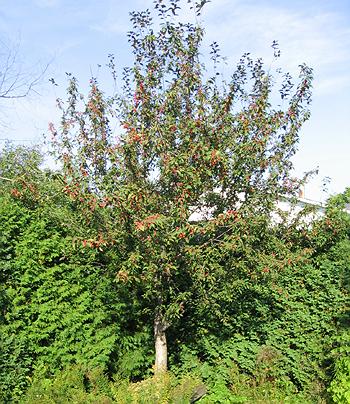 In nature, architecture provides food as well as shelter. Some food
trees suited to small Valley lots are: dwarf North Star cherry,
with nice blooms and loads of thrush-attracting fruit in July.
Crabapples that don't drop their fruit when ripe, especially
Profusion, for waxwings and pine grosbeaks in winter.
Mountain ash - avoid ash selected for fruit so bitter that the
birds won't eat it, some people prefer decorative fruit to birds!
Morden hawthorn is a superb bird tree, but should not be planted
where red-cedar (Juniperus virginana)
grows as these two combine to support a very destructive rust.
In nature, architecture provides food as well as shelter. Some food
trees suited to small Valley lots are: dwarf North Star cherry,
with nice blooms and loads of thrush-attracting fruit in July.
Crabapples that don't drop their fruit when ripe, especially
Profusion, for waxwings and pine grosbeaks in winter.
Mountain ash - avoid ash selected for fruit so bitter that the
birds won't eat it, some people prefer decorative fruit to birds!
Morden hawthorn is a superb bird tree, but should not be planted
where red-cedar (Juniperus virginana)
grows as these two combine to support a very destructive rust.
Shrubs provide even more food and cover per square meter than trees,
and they bear fruit faster too. Consider Russian olive, silverberry
(Shepherdia argentea),
apple serviceberry, amur honeysuckle, common
elderberry and snowberry. Bittersweet and wild grape vines are good
for birds too. To attract hummingbirds, plant bergamot, honeysuckle,
morning glory, petunias, phlox, scarlet runner beans and tiger
lilies.
In summer, provide water that birds can hear, splashing in a
shallow pond,
near a deciduous tree for a preening perch, and away from cat
cover. The cheapest bath is a garbage can lid on the ground. The best
is a sloping puddle lined with building plastic, just deep enough (15
cm) at the center to cover a little pond pump.
Helpful nesting material will also attract birds in the spring -
stick cotton batting, dryer fluff, feathers, or torn-up cloth in a
suet feeder or in a hedge (not in the bird box).
Is your lot one of those 2-5 hectare "estate lots"?
Don't "clean the place up" from one end to the other!
Brush is beautiful to wild creatures. Leave some. Plant a
Siberian crabapple or Black Cherry (they are large). Black Cherry
blossoms appear early in the spring, and the small green seed starts
to form immediately. At this time of year it is a favourite feed for birds,
and by the end of June almost all of the immature fruit will have been
turned into healthy birds. Or,
try a group of bayberry or silver buffaloberry shrubs or white ash
trees. (These three are one-sex-to-a-plant. Only the female ash trees
have seeds.) If your large trees lack variety, add nut-bearing kinds.
Although these do "grow" squirrels, they also attract grouse,
partridge and nuthatches.
Girdle a tree of a common variety (to kill it) every two or three
years to attract woodpeckers. Look at your land through the eyes of a
bird, to appreciate the beauty of an old hollow tree laden with
nutritious fungi and insects.
If you are a rural resident, you have even more options. Create a
colourful bramble patch with Grootendorst roses. (They are less
rampant spreaders than multiflora roses, and bloom from June to
October.) To enjoy an overwintering robin, or pine grosbeaks, plant a
staghorn sumac clump, where you can mow around it for at least 3
meters to prevent it taking over everything. Manchurian bamboo
provides attractive cover and insect food for vireos, catbirds and
sparrows. It needs a mowing strip too. Finally, plant an evergreen or
two for shelter and nesting, white pine in moist areas, red pine in
dry.
Surround a patch with shrubs, for edge effect and to restrict
wind-blown seeds. Let it grow wild with seed-bearing weeds, like
lambsquarters, which hold their seeds through the winter. The birds
will soon plant those they like the best, for many seeds are designed
to sprout after passage through a bird's gizzard. Mow once a year, in
the spring, to keep it weedy.
I must note here that the Ontario Weed Act prescribes the
extermination, throughout the entire province, of 23 species of
plants, including all thistles and milkweed. You might wish to
consider whether or not goldfinches that use thistles for winter
food, and monarch butterflies that can raise their young only on
milkweeds, have an equal right to demand our extermination. To nature
there is no such thing as a "weed".
Don't forget that you are part of nature too. Lay out the plants and
feeders so that you have a good viewing window. It should be in a
room without a window opposite, so birds won't be alarmed by your
movement, and with a good overhang to shade the glass from direct
sun. Make it a comfortable spot for knitting or reading, and relax
with your new-found avian friends.
main page
next page
 Don't feeders encourage misfits to survive in violation of nature?
Every year, it is true, many birds, due to some flaw, do not migrate
as they should. A few are attracted to the area of a feeder during
their last days. But, such birds as the Christmas 1984 black-throated
green warbler in Hull will not survive the winter, feeders or no
feeders. Birds that stay here successfully to expand their range are
generally non-migrants, such as cardinals. They need only suitable
food to handle winter temperatures. We have done so much to curtail
many bird ranges through destruction of food-providing wetlands.
(Roger Tory Peterson once estimated that half a billion birds had
been eliminated from North America "by the simple process of
digging ditches".) Why shouldn't we take a bit of satisfaction
when we help expand some? Go for it!
Don't feeders encourage misfits to survive in violation of nature?
Every year, it is true, many birds, due to some flaw, do not migrate
as they should. A few are attracted to the area of a feeder during
their last days. But, such birds as the Christmas 1984 black-throated
green warbler in Hull will not survive the winter, feeders or no
feeders. Birds that stay here successfully to expand their range are
generally non-migrants, such as cardinals. They need only suitable
food to handle winter temperatures. We have done so much to curtail
many bird ranges through destruction of food-providing wetlands.
(Roger Tory Peterson once estimated that half a billion birds had
been eliminated from North America "by the simple process of
digging ditches".) Why shouldn't we take a bit of satisfaction
when we help expand some? Go for it!
 You are going to feed birds, then. What food is the best?
You are going to feed birds, then. What food is the best?
 Finally, blue jays are particularly attracted to peanuts, pine
siskins are claimed to love cracked buckwheat, and goldfinches seem
to be the only species to eat whole flax. Hummingbirds take sugar
water, 1 part sugar to 4 parts water, changed every few days to avoid
fermentation. (They eat insects for protein.) Niger seed is very
attractive to small finches. But at its price, Niger is worth it only
to a feeder fanatic.
Finally, blue jays are particularly attracted to peanuts, pine
siskins are claimed to love cracked buckwheat, and goldfinches seem
to be the only species to eat whole flax. Hummingbirds take sugar
water, 1 part sugar to 4 parts water, changed every few days to avoid
fermentation. (They eat insects for protein.) Niger seed is very
attractive to small finches. But at its price, Niger is worth it only
to a feeder fanatic.
 There is no doubt about it - "grey" squirrels (most in urban
Canada are black coloured, not grey) can be a problem. They are less
territorial than red squirrels are, so their population grows
impossibly. They eat appalling quantities of sunflower seed, and chew
up plastic feeders to get the last few grains out. They occasionally
rip open mesh bags and abscond with suet, too. Then, come spring,
they go after our tulips.
There is no doubt about it - "grey" squirrels (most in urban
Canada are black coloured, not grey) can be a problem. They are less
territorial than red squirrels are, so their population grows
impossibly. They eat appalling quantities of sunflower seed, and chew
up plastic feeders to get the last few grains out. They occasionally
rip open mesh bags and abscond with suet, too. Then, come spring,
they go after our tulips.

 Most lawn-spray companies, for economy of application, mix their
chemicals to deal with the worst lawns within the area covered by their
Most lawn-spray companies, for economy of application, mix their
chemicals to deal with the worst lawns within the area covered by their
 In the Valley, 28 species of birds nest in cavities, and might be
lured to stay near you by a suitable bird box. In nature there are
rarely enough nesting cavities to go around. The populations of tree
swallows and bluebirds in particular seem to be limited primarily by
the availability of nest sites, not by food. So, concocting an
easy-to-build nest box can really help birds. (To a bird, the perfect
bird box is one that gets built!) Here is a recipe.
In the Valley, 28 species of birds nest in cavities, and might be
lured to stay near you by a suitable bird box. In nature there are
rarely enough nesting cavities to go around. The populations of tree
swallows and bluebirds in particular seem to be limited primarily by
the availability of nest sites, not by food. So, concocting an
easy-to-build nest box can really help birds. (To a bird, the perfect
bird box is one that gets built!) Here is a recipe.
 In nature, architecture provides food as well as shelter. Some food
trees suited to small Valley lots are: dwarf North Star cherry,
with nice blooms and loads of thrush-attracting fruit in July.
Crabapples that don't drop their fruit when ripe, especially
Profusion, for waxwings and pine grosbeaks in winter.
Mountain ash - avoid ash selected for fruit so bitter that the
birds won't eat it, some people prefer decorative fruit to birds!
Morden hawthorn is a superb bird tree, but should not be planted
where red-cedar (Juniperus virginana)
grows as these two combine to support a very destructive rust.
In nature, architecture provides food as well as shelter. Some food
trees suited to small Valley lots are: dwarf North Star cherry,
with nice blooms and loads of thrush-attracting fruit in July.
Crabapples that don't drop their fruit when ripe, especially
Profusion, for waxwings and pine grosbeaks in winter.
Mountain ash - avoid ash selected for fruit so bitter that the
birds won't eat it, some people prefer decorative fruit to birds!
Morden hawthorn is a superb bird tree, but should not be planted
where red-cedar (Juniperus virginana)
grows as these two combine to support a very destructive rust.